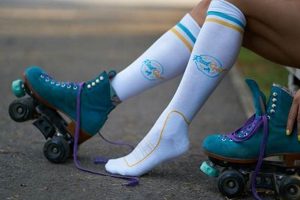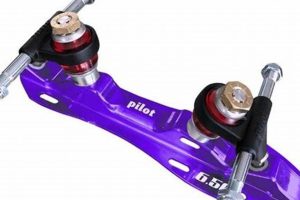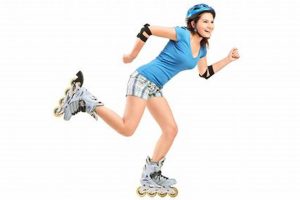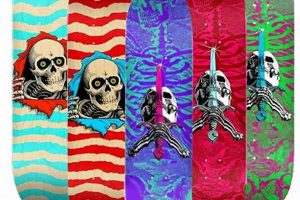Maintaining equilibrium on a skateboard at an advanced level relies heavily on the precise distribution of weight and coordinated movements. This skill necessitates a deep understanding of physics, anatomy, and board dynamics. For example, achieving complex tricks requires instantaneous adjustments to counter rotational forces and maintain a stable center of gravity.
Superior stability enhances control, minimizes the risk of injury, and enables the execution of progressively challenging maneuvers. Historically, the mastery of this skill has differentiated amateur skaters from professionals, allowing the latter to push the boundaries of the sport and achieve greater heights in competition and performance. It is a foundational element for advanced skating, underpinning all aspects of trick execution and stylistic expression.
The following sections will delve into the specific techniques, training methodologies, and equipment considerations that contribute to the development of exceptional stability. We will explore biomechanical principles, practical exercises, and the influence of board design on achieving optimal equilibrium.
Enhancing Stability on a Skateboard
The following guidance offers actionable strategies to improve equilibrium on a skateboard, applicable to individuals aspiring to enhance their technical skills and minimize the likelihood of falls.
Tip 1: Core Engagement: Consistently activate abdominal and back muscles to create a stable torso. This acts as a central anchor point, allowing for quicker adjustments to shifting weight and providing a solid foundation for limb movements. Example: Before initiating any trick, consciously tighten the core to maintain a neutral spine.
Tip 2: Stance Optimization: Experiment with varying foot positions on the board to identify the most stable configuration. A wider stance generally provides greater stability, particularly during landings and transitions. Example: Adjust foot placement incrementally during stationary practice to find the optimal balance point over the trucks.
Tip 3: Visual Focus: Maintain a clear and consistent focal point. This provides the brain with crucial information about movement and orientation, aiding in balance regulation. Example: When approaching a ramp, fixate on the transition point to anticipate the change in elevation and adjust accordingly.
Tip 4: Ankle Flexibility: Implement exercises to enhance ankle mobility. Flexible ankles allow for a greater range of motion and quicker adjustments to compensate for uneven surfaces or unexpected shifts in weight. Example: Regularly perform ankle rotations and stretches to improve joint flexibility and responsiveness.
Tip 5: Gradual Progression: Systematically advance skill development, mastering foundational techniques before attempting more complex maneuvers. This builds a solid base of stability and reduces the risk of attempting tricks beyond current capabilities. Example: Before attempting a kickflip, ensure consistent mastery of the ollie.
Tip 6: Weight Distribution Awareness: Consciously monitor and adjust weight distribution on the board. Small shifts in weight can significantly impact stability, particularly during grinds and slides. Example: During a 50-50 grind, slightly lean into the direction of the grind to maintain balance and prevent falling off the ledge.
Tip 7: Practice Fall Techniques: Learning how to fall safely minimizes the potential for injury. Practice rolling upon impact and protecting vital areas. Example: Practice falling on soft surfaces, focusing on tucking and rolling to distribute impact forces.
Implementing these strategies consistently will contribute to a noticeable improvement in stability and control on the skateboard, ultimately enhancing performance and reducing the risk of injury.
The following sections will explore advanced techniques and equipment considerations relevant to further optimizing equilibrium and maximizing performance.
1. Core Strength
Core strength is a foundational component of advanced skateboarding, directly impacting stability, control, and the ability to perform complex maneuvers. A robust core musculature acts as the central stabilizing force, enabling effective transfer of power between the upper and lower body, and facilitating rapid adjustments to maintain equilibrium.
- Spinal Stabilization
The core muscles, including the transverse abdominis, obliques, and erector spinae, work synergistically to stabilize the spine. This prevents excessive movement and reduces the risk of injury, particularly during high-impact landings and rapid directional changes. Without adequate spinal stabilization, the skater’s center of gravity becomes less predictable, increasing the likelihood of imbalance and potential falls.
- Torso Rotation Control
Many skateboarding tricks require precise torso rotation. A strong core allows for controlled and efficient rotation, enabling the skater to initiate and execute spins, flips, and other rotational maneuvers with greater accuracy. Conversely, a weak core can lead to uncontrolled rotation, compromising balance and control during trick execution.
- Power Transfer Efficiency
The core acts as a conduit for transferring power generated by the legs to the upper body and vice versa. This is particularly crucial for generating the force required for ollies, kickflips, and other explosive tricks. A strong core facilitates a seamless transfer of power, maximizing the skater’s ability to generate height, speed, and control.
- Balance Recovery Mechanism
Even with optimal technique, skaters inevitably encounter situations that challenge their equilibrium. A strong core allows for rapid and effective balance recovery by enabling quick adjustments to counteract unexpected shifts in weight or external forces. This reduces the likelihood of falls and allows the skater to maintain control even in challenging circumstances.
In summary, core strength is not merely a supplementary fitness component but an integral requirement for achieving and maintaining equilibrium at an advanced level of skateboarding. Its influence extends from spinal stabilization and torso rotation control to power transfer efficiency and balance recovery, solidifying its role as a cornerstone of superior stability on a skateboard.
2. Weight Distribution
Precise management of weight distribution is inextricably linked to achieving advanced equilibrium on a skateboard. Weight placement dictates the board’s response to rider input, profoundly influencing stability and control. Imbalances in weight can lead to instability, reduced maneuverability, and an increased risk of falls, while optimized weight distribution provides a solid foundation for complex trick execution. For example, maintaining an even weight distribution while approaching a rail grind ensures a stable approach, reducing the likelihood of slipping out upon contact. Conversely, shifting weight too far forward or backward during a manual can result in loss of control and a failed attempt.
Effective weight distribution is not static; it requires constant adjustment in response to changing conditions and intended maneuvers. During an ollie, for instance, the rider initially shifts weight backward to pop the tail, then quickly redistributes it forward to level out the board. This dynamic shift requires a heightened awareness of body positioning and board dynamics. Consider the execution of a kickflip: the skater initiates a slight shift in weight towards the heelside edge while simultaneously flicking the board, requiring immediate and precise re-centering to land cleanly. This demonstrates the direct cause-and-effect relationship between weight distribution and trick completion.
Understanding the principles of weight distribution is paramount for any skater aspiring to progress beyond basic techniques. The ability to intuitively adjust weight in response to various forces and board movements is what separates novice riders from seasoned professionals. Mastery of this aspect allows for greater confidence, consistency, and ultimately, the ability to push the boundaries of what is possible on a skateboard. The skater must consistently monitor and recalibrate their position, emphasizing the importance of awareness and fine-tuning in achieving advanced-level skills.
3. Ankle Flexibility
Ankle flexibility directly impacts a skateboarder’s ability to maintain equilibrium, especially during complex maneuvers and landings. Restricted ankle mobility inhibits the skater’s capacity to compensate for imbalances, increasing the likelihood of falls. The ankle joint acts as a crucial shock absorber, dissipating impact forces and facilitating subtle adjustments essential for stability. Reduced range of motion in the ankle translates to diminished responsiveness to changes in terrain or board dynamics. For example, a skater with limited dorsiflexion may struggle to absorb the impact of landing a jump, leading to potential ankle injuries or a loss of balance. The capacity to quickly invert or evert the foot allows for precise corrections, maintaining board control during grinds, slides, and transitions.
Specific exercises targeting ankle flexibility, such as calf stretches, ankle rotations, and resistance band drills, can significantly improve a skater’s ability to react to unexpected forces and maintain a stable center of gravity. Consistent training yields enhanced proprioception, allowing the skater to instinctively adjust their foot position and weight distribution to counteract imbalances. Moreover, greater ankle flexibility enhances the execution of tricks requiring subtle foot movements, such as kickflips and heelflips, where precise ankle articulation is necessary to generate the desired board rotation. Neglecting ankle flexibility can result in reliance on other joints and muscle groups to compensate, leading to inefficient movement patterns and an increased risk of injury.
In conclusion, ankle flexibility represents a crucial, often underestimated component of a skater’s ability to achieve and maintain advanced equilibrium. Enhancing ankle mobility through targeted training improves responsiveness, reduces the risk of injury, and unlocks the potential for more advanced maneuvers. The practical significance of this understanding lies in its ability to optimize performance and prolong an athlete’s career by promoting biomechanically sound movement patterns.
4. Visual Acuity
Visual acuity, defined as the sharpness or clarity of vision, represents a fundamental component of advanced skateboarding, directly influencing a skater’s ability to maintain equilibrium and execute complex maneuvers with precision. The demands of skateboarding require constant assessment of spatial relationships, environmental conditions, and the board’s orientation in relation to the surrounding environment. Deficiencies in visual acuity can compromise these assessments, leading to instability and increased risk of injury.
- Spatial Awareness and Depth Perception
Accurate assessment of distances and depths is crucial for tasks such as approaching obstacles, landing jumps, and navigating transitions. Compromised depth perception hinders the skater’s ability to judge distances accurately, increasing the risk of misjudged landings and collisions. The constant calculation of spatial relationships between the board, the skater, and the environment hinges on the skater’s sharpness of vision.
- Motion Tracking and Anticipation
Skateboarding involves dynamic movement and rapid changes in direction. Visual acuity enables the skater to track these movements and anticipate future board states. This is critical for maintaining balance during rotations, slides, and grinds. Visual input allows the skater to predict the trajectory of the board and adjust body position accordingly. For example, when skating at a park, the skateboarder should notice and avoid the surroundings.
- Environmental Hazard Detection
The skateboarding environment presents a variety of potential hazards, including cracks, debris, and other skaters. Sharp vision enables the skater to detect these hazards early and react accordingly, preventing accidents and maintaining stability. Inability to quickly identify dangers can lead to accidents and poor decision-making.
- Board Orientation and Control
Visual input provides the skater with constant feedback about the board’s orientation, allowing for precise adjustments and control. During complex maneuvers such as kickflips and heelflips, visual cues enable the skater to track the board’s rotation and time the landing accurately. Effective monitoring improves overall responsiveness, coordination, and trick execution.
In summary, visual acuity constitutes a critical element of advanced skateboarding, enabling spatial awareness, motion tracking, hazard detection, and board orientation. Optimal visual function allows for precise control, enhanced performance, and reduced risk of injury. The development and maintenance of sharp vision is therefore integral to maximizing potential and achieving superior stability on a skateboard.
5. Stance Alignment
Stance alignment, the positioning of the feet on the skateboard relative to the rider’s center of gravity and the board’s longitudinal axis, represents a critical determinant of equilibrium. Suboptimal stance alignment compromises stability, diminishes control, and impedes the execution of advanced skateboarding maneuvers. Conversely, proper stance alignment promotes balance, enhances responsiveness, and allows for efficient force transmission, ultimately contributing to superior board control.
- Foot Placement and Center of Gravity
The placement of the feet directly influences the skater’s center of gravity relative to the board. A stance too far forward or backward disrupts the skater’s balance, leading to instability, especially during landings or transitions. Centering the feet over the trucks optimizes weight distribution, providing a more stable platform. For example, a skater attempting a manual with the rear foot positioned too far back will find it difficult to maintain the balance point, resulting in an unstable ride.
- Foot Angle and Board Responsiveness
The angle of the feet on the board affects the skater’s ability to initiate turns and control board direction. A stance with feet angled excessively inward or outward reduces the skater’s ability to apply pressure to the edges of the board effectively, diminishing responsiveness. Aligning the feet with the board’s longitudinal axis, or with a slight angle, enhances the skater’s ability to control the board’s direction and initiate turns. A skater with feet pointed perpendicular to the board will find it extremely difficult to carve a turn effectively.
- Stance Width and Stability
The distance between the feet on the board impacts stability. A wider stance typically provides greater stability, especially during landings and high-impact maneuvers. However, an excessively wide stance can reduce mobility and limit the skater’s ability to perform certain tricks. A narrower stance, while promoting agility, may compromise stability, particularly during off-axis landings. Determining the optimal stance width depends on the skater’s body type, preferred style, and the specific maneuver being attempted.
- Consistency and Habitual Positioning
Developing a consistent stance alignment is crucial for building muscle memory and promoting instinctive reactions. Regularly practicing and refining stance alignment enables the skater to quickly and efficiently assume the optimal position for various maneuvers. Deviations from the established stance alignment can lead to inconsistencies in performance and increased risk of falls. A skater who consistently places their feet in the same position on the board before attempting a trick will have a significantly greater chance of success compared to a skater who varies their stance randomly.
The relationship between stance alignment and advanced skateboarding equilibrium is undeniable. Optimizing foot placement, angle, and width provides a solid foundation for control and responsiveness. Cultivating a consistent and habitual stance promotes muscle memory and allows for effortless execution of advanced maneuvers. Stance alignment is not merely a static attribute but a dynamic element requiring constant attention and refinement. The dedication to stance optimization has direct influence to skateboarding.
6. Board Control
Board control is integral to achieving advanced-level equilibrium on a skateboard. The capacity to precisely manipulate the board’s movement directly influences stability and maneuverability, thereby impacting overall performance. Effective board control is not merely a skill but a dynamic process necessitating constant adjustment and adaptation to varying conditions.
- Edge Control
Edge control refers to the ability to apply pressure to the edges of the skateboard, influencing its direction and stability. Proper edge control is crucial for carving turns, maintaining balance during grinds and slides, and executing various flip tricks. Insufficient edge control can lead to instability and loss of control. During a heelside carve, for example, a skater must apply pressure to the heelside edge of the board to initiate and maintain the turn. Failure to apply sufficient pressure results in the board straightening out and the turn failing.
- Weight Distribution and Steering
Weight distribution is intrinsically linked to steering. Small shifts in weight can significantly alter the board’s trajectory, enabling the skater to navigate obstacles and execute intricate maneuvers. Proper weight distribution enables the skater to steer the board precisely and maintain balance throughout the movement. For instance, when executing a manual, the skater must shift their weight rearward to lift the front wheels off the ground, and then subtly adjust their weight to maintain the balance point and steer the board. Overcorrection or insufficient weight shift will result in either falling backward or losing the manual.
- Foot Placement and Board Feel
The positioning of the feet on the board provides tactile feedback, known as “board feel.” This feedback allows skaters to sense the board’s movement and react accordingly. Proper foot placement enables the skater to anticipate changes in board behavior and adjust their weight and balance to maintain control. A skater who is intimately familiar with their board’s response to various foot positions will be better equipped to handle unexpected situations and execute complex maneuvers. Subtle adjustments of foot placement, in both angle and location, enable a wider range of motion.
- Impact Absorption and Dampening
The ability to absorb and dampen impact forces is critical for maintaining equilibrium, particularly during landings. Using the ankles and knees to absorb impact reduces stress on the joints and helps maintain stability. Effective impact absorption enables the skater to land tricks smoothly and maintain control even when the landing is not perfect. Failure to absorb impact effectively can lead to instability, injury, and an inability to maintain balance following the landing.
These facets collectively highlight the significance of board control in achieving advanced-level equilibrium on a skateboard. Mastery of these aspects provides the skater with a heightened sense of awareness, enabling the seamless integration of board movement and body positioning. This comprehensive control directly translates to enhanced stability, improved trick execution, and a reduced risk of injury.
Frequently Asked Questions
The following addresses common inquiries related to achieving and maintaining advanced stability on a skateboard. These questions and answers aim to provide clarity and guidance on core concepts.
Question 1: How does core strength contribute to stability on a skateboard?
Core strength stabilizes the spine, facilitates power transfer, and enables rapid balance recovery. A robust core musculature provides a central anchor, allowing for efficient adjustments to shifting weight and external forces.
Question 2: What is the significance of weight distribution in maintaining equilibrium on a skateboard?
Weight distribution dictates the board’s response to rider input. Precise weight management promotes stability, enhances maneuverability, and reduces the risk of falls. Shifting the weight requires the understanding and skill.
Question 3: How does ankle flexibility influence a skater’s ability to maintain balance?
Ankle flexibility allows for compensatory movements to counteract imbalances. Flexible ankles facilitate impact absorption and enable quick adjustments to changing terrain or board dynamics.
Question 4: What role does visual acuity play in achieving stability on a skateboard?
Visual acuity enables spatial awareness, motion tracking, and hazard detection. Sharp vision allows for precise assessments of distances, depths, and environmental conditions, contributing to improved control.
Question 5: How does stance alignment affect a skater’s ability to control the board?
Stance alignment influences weight distribution, board responsiveness, and stability. Proper foot placement and angle optimize balance and allow for efficient force transmission, enhancing overall control.
Question 6: What key elements contribute to board control, and how does it impact equilibrium?
Edge control, weight distribution, foot placement, and impact absorption are critical components of board control. Effective control enables precise board manipulation, enhances stability, and reduces the risk of injury.
Mastering these aspects of skating empowers the rider to achieve the control needed for maneuvers.
The subsequent article sections will explore advanced training methodologies and equipment considerations relevant to maximizing skating.
Pro Skate Balance
This exploration has underscored the multifaceted nature of advanced skateboarding stability. The convergence of core strength, weight distribution, ankle flexibility, visual acuity, stance alignment, and precise board control dictates the capacity to execute complex maneuvers with consistency and mitigate the potential for injury. Each element warrants dedicated training and refinement to maximize performance.
The pursuit of optimal equilibrium is a continuous endeavor, demanding rigorous practice, self-assessment, and a commitment to refining biomechanical proficiency. Mastery of these principles provides the foundation for pushing the boundaries of skateboarding and achieving peak athletic expression. Therefore, a thorough and informed pursuit remains crucial for continued progression and safeguarding well-being within the sport.







